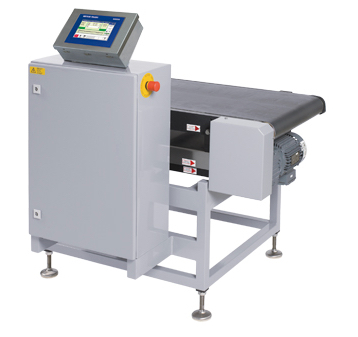In Motion Check Weigh and Manifesting.

Streamline Weigh-It™ In-motion weight scale is a perfect addition to a Streamline order picking system. Coupled with the Streamline-It products, you can receive, store, pick, check, pack, weigh, manifest and ship all within the same system controls. Our systems software is designed to work with the controls and automated equipment, so there is only one source for system issues. Our products are made to work with each other, so your operation runs smoother. Although our systems software, controls and hardware are made to work seamlessly together, we also play well with others and have made our systems compatible for any operation.
A check weigher is an automatic or manual machine for checking the weight of packaged commodities. It is normally found at the off going end of a production process and is used to ensure that the weight of a pack of the commodity is within specified limits. Any packs that are outside the tolerance are taken out of line automatically. A check weigher can weigh in excess of 500 items per minute (depending on carton size and accuracy requirements). Checkweighers often incorporate additional checking devices such as metal detectors and X-ray machines to enable other attributes of the pack to be checked and acted upon accordingly.
Increasing throughput and reducing labor costs using our equipment for packing, weighing, manifesting, printing and applying shipping labels, and sorting packages in one continuous movement without any human intervention. Reducing your shipping costs by more than 50% or more. Reducing or eliminating product damage that is commonly experienced during shipping.
Interested in one of our solutions?
Contact us today so that we can build a solution custom fit for your business needs.
1. An infeed belt that may change the speed of the package and to bring it up or down to a speed required for weighing. The infeed is also sometimes used as an indexer, which sets the gap between products to an optimal distance for weighing. It sometimes has special belts or chains to position the product for weighing.
2. A weigh belt. This is typically mounted on a weight transducer which can typically be a strain-gauge load cell or a servo-balance (also known as a force-balance), or sometimes known as a split-beam. Some older machines may pause the weigh bed belt before taking the weight measurement. This may limit line speed and throughput.
3. A reject belt that provides a method of removing an out-of-tolerance package from the conveyor line. The reject can vary by application. Some require an air-amplifier to blow small products off the belt, but heavier applications require a linear or radial actuator. Some fragile products are rejected by “dropping” the bed so that the product can slide gently into a bin or other conveyor.
For high-speed precision scales, a load cell using electromagnetic force restoration (EMFR) is appropriate. This kind of system charges an inductive coil, effectively floating the weigh bed in an electromagnetic field. When the weight is added, the movement of a ferrous material through that coil causes a fluctuation in the coil current proportional to the weight of the object. Other technologies used include strain gauges and vibrating wire load cells.
It is usual for a built-in computer to take many weight readings from the transducer over the time that the package is on the weigh bed to ensure an accurate weight reading.
Calibration is critical. A lab scale, which usually is in an isolated chamber pressurized with dry nitrogen(pressurized at sea level) can weigh an object within plus or minus 100th of a gram, but ambient air pressure is a factor. This is straightforward when there is no motion, but in motion there is a factor that is not obvious-noise from the motion of a weigh belt, vibration, air-conditioning or refrigeration which can cause drafts. Torque on a load cell causes erratic readings.
A dynamic, in-motion checkweigher takes samples, and analyzes them to form an accurate weight over a given time period. In most cases, there is a trigger from an optical(or ultrasonic) device to signal the passing of a package. Once the trigger fires, there is a delay set to allow the package to move to the “sweet spot” (center) of the weigh bed to sample the weight. The weight is sampled for a given duration. If either of these times are wrong, the weight will be wrong. There seems to be no scientific method to predict these timings. Some systems have a “graphing” feature to do this, but it is generally more of an empirical method that works best.
A reject conveyor to enable the out-of-tolerance packages to be removed from the normal flow while still moving at the conveyor velocity. The reject mechanism can be one of several types. Among these are a simple pneumatic pusher to push the reject pack sideways from the belt, a diverting arm to sweep the pack sideways and a reject belt that lowers or lifts to divert the pack vertically. A typical checkweigher usually has a bin to collect the out-of-tolerance packs. Sometimes these bins are provided with a lock, to prevent that out of specification items are fed back on the conveyor belt.

